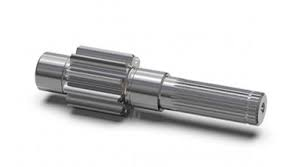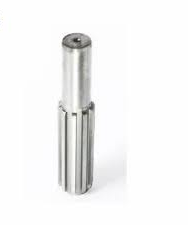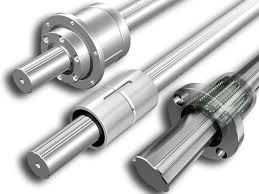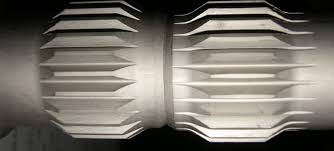Spline Shaft Guide: Types, Standards, & Materials
 Apr 10,2025
Apr 10,2025

If you see yourself from a chair to a space station, you will observe technology everywhere. Shafts have been in use since the invention of the wheel. It means it works as a backbone in the machines. If we describe a shaft in simple terms, its function is to transmit torque, momentum, and motion to connected parts. There are many types of shafts, but this article mainly focuses on spline shafts and its further types, its manufacturing materials, etc. So, let us introduce what is a spline shaft:
What is a Spline Shaft? Definition and Core Mechanics
The spline shaft is a core component of a machine. It contains ridges with a groove in the mating part. It facilitates torque transfer and alignment in the machine parts. These shafts help machines prevent wear or slippage by distributing the load evenly.
Spline Shaft vs. Keyed Shaft: When to Use Which?
The criteria are simple to choose between a spline shaft and a keyed shaft. If the application requires high precision and torque management, a spline shaft is the best choice. The keyed shafts are suitable where low torque and cost-effectiveness matter.
Torque Capacity Comparison
The design of a component affects its ability to bear torque. The general tests, such as shear load and fatigue testing, show that a spline shaft can easily take 30% more torque than a keyed shaft.
Alignment Precision
The backlash in robotics and CNC equipment creates the issues of alignment precision. Spline shafts eliminate the backlash issue and maintain alignment in the working.
What Defines a Spline Shaft?
Key parameters are:
- Teeth profile, e.g. involute
- Root diameter
- Pressure angle, i.e. 30omostly in industrial applications
5 Critical Functions of Spline Shafts in Modern Machinery
As we mentioned earlier, a spline shaft is the backbone of modern machinery. It is due to these critical functions, which are briefly discussed below:
1. Torque Transmission without Slippage
As we mentioned earlier, the spline shafts transfer power to connected wheels efficiently. That's used in automotive drivetrains.
2. Axial Movement Accommodation
Linear actuators mainly rely on spline shafts because they provide alignment during movement.
3. Vibration Damping via Distributed Loads
Spline shafts facilitate the uniform distribution of loads, which helps in damping the vibration.
4. Precision Alignment in CNC Equipment
CNC operations are high-speed operations, spline shafts maintain tolerances providing precision alignment.
5. Fail-Safe Disengagement
Spline shafts protect systems by disengaging during overloads.
Spline Shaft Types: A Designer's Selection Guide
It ultimately depends on the application demands, like the type of load, speed, etc. to choose which type of spline shaft.
Involute Splines (DIN 5480 / ISO 4156)
An international standard, i.e. ISO 4156 and a European standard DIN i.e. 5480, have the information for involute spline shafts. In industries, involute splines are the most common shafts because of
- Self-Aligining
- 30° Pressure Angle
- Gradual Load Transfer

Applications
- Automotive Transmissions
- Industrial gearbox
- Aerospace Actuators
Why a 30° Pressure Angle is Ideal for Industrial Applications
30% pressure angle is suitable for 80% of industrial applications. The reason is that this angle makes a balance between the load capacity and fatigue life.
Straight-Sided Splines (SAE J498)
Straight-sided splines are simple and easy to manufacture. They have the profile of flat-flanked teeth on the surface. They are not so efficient in load distribution.
Properties
- RPM limit: best <500
- Flat-tooth flanks
- Lower cost

Applications
- Agricultural industry (tractor shafts)
- Hydraulic Pumps
- Legacy industrial equipment
Low-cost alternative for <500 RPM applications
<500 RPM means moderate speed and torque. To operate under these conditions, straight-sided splines are best because they are cost-effective as well.
Serrated Splines (Military spec MIL-S-8879)
Serrated splines have aggressive 45o angled teeth, which is helpful to bear axial shock loads, vibration extremes and high-misalignment scenarios.
These serrated splines are used in
- Black Hawk helicopter rotor shafts
- Missile launch rail actuators

45° Serrations for Military-Grade Axial Loads
Designed for extreme axial load handling in helicopter rotor systems.
Ball Splines:
Ball Splines provide the following advantages due to linear motion in the system.
- Approximately zero backlash due to hardened rolling elements
- 90% less friction than keyed shafts
- 10X longer life in high-cycle applications

Applications
- Semiconductor wafer handlers
- Medical Robotics
- 6-axis CNC trunnion tables
Crowned Splines: Compensating for Misalignment
Crowned splines have a barrel-shaped profile (controlled crown radius), which helps in
- Self-correct angular movement
- Even distribution of load
- 300% enhanced lifetime

Applications
- Wind turbine gearboxes
- Ship propulsion shafts
- Mining conveyor drives
How To Manufacture Spline Shaft? -Step-to-Step
In this section, we will see step-by-step how we can prepare a spline shaft precisely:
- Step 1: Design Validation & Tolerance Mapping
These are some critical operations to carry out in this step:
✔3D FEA Simulation– ANSYS software is used to verify stress distribution under max torque
✔Tolerance Stack Analysis– ISO 4156 Class 5 is used to account for thermal expansion
✔Spline Profile Selection– Involute DIN 5480 and straight SAE J498
Tool:
- Gear design software(KISSsoft, Romax)
- Step 2: Material Preparation & Pre-Machining
Material preparation involves multiple steps
- Material Cutting
Cut steel bars through cutting machines
Turning
Perform turning operations through Lathe, and for more precise turning, use CNC machines.
Diameter: ±0.05mm
Surface Finish: Ra 3.2μm
- Drilling: For accurate between-centres machine
It is considered a wise option to perform annealing for stress relief to prevent distortion.
- Step 3: Primary Spline Formation
The following are the operations for primary spline formation:
- Broaching
Tungsten carbide broach is used at the speed of 5-15m/min for broaching. DIN 1415 standard is used for broaching. DIN class 7 accuracy is achieved in broaching.
- Hobbing
The CNC gear hobbing machine is used

Tool: HCC hob
Level of tolerance:You can achieve AGMA class 10 tolerance
- Grinding
Used when hardened shafts are required
Thread Grinder machine with CBN wheels
A 0.4μm surface finish is achieved
- Step 4: Post-Processing & Surface Enhancement
Machining operations leave stains and do not produce the desired surface of the products, so some post-processing is always required.
Some post-processing techniques are:
Heat Treatment
To achieve some case hardening
Shot Peening
Enhances fatigue life
Coating
To reduce wear, DLC coatings are often used
- Step 5: Quality Assurance & Testing
Inspection Protocol:
The following protocols are often used for spline shafts:
- CMM Measurement– Tooth profile accuracy (±0.005mm)
- Gear Roll Tester– Checks composite error (DIN 3961)
- Torque Testing– Validates30% higher capacity keyed shafts
Certification:
The spline shafts have to follow these certifications
- ISO 9001process validation
- PPAP documentationfor automotive clients
What Are the Common Spline Shaft Standards? -SAE, DIN, ISO
Standards are like guides for engineers which contain guidance for selecting the material, manufacturing techniques, post-processing techniques, etc. These standards facilitate compatibility and performance in industries.
SAE J500 (Automotive) vs. DIN 5480 (EU Machinery)
SAE J500 is a standard model of Automotive Engineers and is used for stainless steel. DIN 5480 standard is used for mechanical power transmission.
Tooth thickness tolerances
Different standards offer different tolerances, such as ±0.0002" in SAE and ±0.05mm in DIN Class 5.
Metric vs. Imperial Splines
North America uses Imperial splines while Metric splines dominate globally.
How to Understand Spline Codes
Suppose “48x3x30° DIN 5482”, it means
- 48 teeth, 3mm module and 30o is the pressure angle
Spline Shaft Materials Selection: From Aluminum to Super Alloys
The selection of material for a spline shaft affects the applications, and these splines are used according to conditions.
General Industrial Use
In this section, we will generally discuss what are the advantages and disadvantages of these materials for spline shafts. These materials cover 80% of industrial use.
Alloy Steels (4140/4340)

4140 and 4340 are low-medium C alloy steels. Most spline shafts are made of these alloys.
Pros:
- High strength, Toughness and Cost-effectiveness
Cons:
- Susceptibility to corrosion is high because of no Cr content in the composition
Stainless Steel (17-4PH)
PH means that stainless steel is precipitation-hardening martensitic stainless steel, and it is known for its best mechanical properties.
Pros:
- High strength
- High corrosion resistance even in chloride-rich salt environments
- Good Weldability
Cons
This material is difficult to machine, which is why its cost is high. Second, its high-temperature performance is limited.
Lightweight Applications
The following materials are used where light weight is the primary requirement, such as in the aerospace and automotive industries.
Aerospace-Grade Aluminum (7075-T6)
This alloy is specifically made for the aerospace industry using artificial ageing, which means it comes with enhanced mechanical properties.
Pros:
Its mechanical advantages include being 60% lighter than steel, High strength-to-weight ratio and good corrosion resistance.
Cons:
Its fatigue limit is lower than steel.
Titanium Alloy (Ti-6Al-4V)
Aluminium and vanadium are the main alloying elements in this alloy, which makes it suitable for aerospace, medical implants and high-performance engineering applications.
Pros:
This alloy provides the advantages of a high strength-to-weight ratio, good compatibility and ductility with respect to strength.
Cons:
There are 3 big concerns regarding the usage of this alloy
- Poor wear resistance
- Hydrogen Embrittlement
- Risk of Galling and Seizing
Extreme Conditions (High-Temperature/Corrosion)
Oxidation and corrosion are the main challenges in extreme conditions such as high-temperature or salty environments. These materials outperform these conditions:
Nickel-Based Super Alloy (Inconel 718)
Its mechanical properties are extremely good due to Ni and Cr presence. Its applications include aerospace, marine and power generation.
Pros:
Some main advantages of using this material are:
- Outstanding performance in high temperatures
- Extremely good corrosion resistance
- Good fatigue and creep resistance
Cons:
Two disadvantages are its susceptibility to segregation in large castings and high costs due to the expensive alloying elements.
Cobalt-Chromium Alloy (Hastelloy C276)
Mo and Cr are added in larger amounts with a small amount of Co. These alloying elements make it suitable for harsh conditions.
Pros:
The advantages of using this alloy are exceptional corrosion resistance, high-temperature strength and non-magnitic behavior.
Cons:
Two big disadvantages are:
- Limited availability and supply chain issues
- Difficult Machining
Spline Shaft Design: 7 Rules to Prevent Failure
If you are aware of these rules, you can prevent failures in real-life applications.
Tip 1: Avoid Tooth Breakage with AGMA Stress Calculations
Avoid tooth breakage failure using AGMA stress calculations. In this test, we calculate two things:
- Bending Stress at tooth root
- Contact Stress at Flanks
Tip 2: Set Fillet Radius to 0.25×Module for Crack Prevention
Fillet sharp points to 0.25xModule. Fillet increases the lifetime of the object by 400X.
Tip 3: Use Ra 0.8µm Finish to Boost Fatigue Life
Use grinding to achieve an RA of 0.8µm. If the surface finish is poor, endurance will be affected and will lead to fatigue failure.
Tip 4: Cut 45° Helix Grooves to Slash Wear by 60%
Cut 45o Helix grooves to reduce adhesive wear. These grooves are significant in automotive transmissions and hydraulic pumps.
Spline Shaft Applications: Industry-Specific Solutions
In this section, some spline shaft applications are given.
Automotive: 24-spline vs. 26-spline input shafts
The 26-spline can handle forces of 650 Nm, while the 24-spline is a cheaper shaft, which fits best with old designs.
Aerospace: Self-lubricating splines in jet engines
Self-lubricating spline shafts are used to eliminate grease contamination in fan blade pitch systems from -60°C to 300°C.
Robotics: Polymer-coated splines for silent operation
For silent operations, PEEK coatings are used for spline shafts in robotics. These coatings also enhance corrosion resistance.
Spline Shaft Maintenance and Repair Techniques
We will see how we can do maintenance and repair of spline shafts in this section.
Re-splining: When to re-cut vs. replace
- Re-cut when:
- Minor wear
- Low-Hardness shafts
- Non-critical applications
- Replacewhen:
Replace is a better option in case of:
- Cracked roots
- High-Hardness shafts
- Critical loads
Note
- Re-splining saves 50% in costs as compared to replacement.
Anti-wear coatings:
DLC and Nickel-Teflon are two common anti-wear coatings. DLC is far better than Nickel-Tungsten for wear resistance in critical applications.
Conclusion:
We conclude that the spline shaft is the core component of any machine and is responsible for the successful transmission of torque and movement in all machines. If you wisely choose the right material, spline type, and design, you can achieve the best performance with these splines in real-life applications.
FAQs
What's the difference between SAE and DIN spline standards?
SAE standard ensures tight tolerance in the components of the automotive industry, while the DIN standard is common in Europe.
How to align spline shafts during assembly?
Use alignment pins or measure runout with a dial indicator.
 Tel/WeChat:
Tel/WeChat:  Email:
Email: 
 Home
Home
 What’s The Best Material for Robot Hardware? -Structural Parts
What’s The Best Material for Robot Hardware? -Structural Parts 







